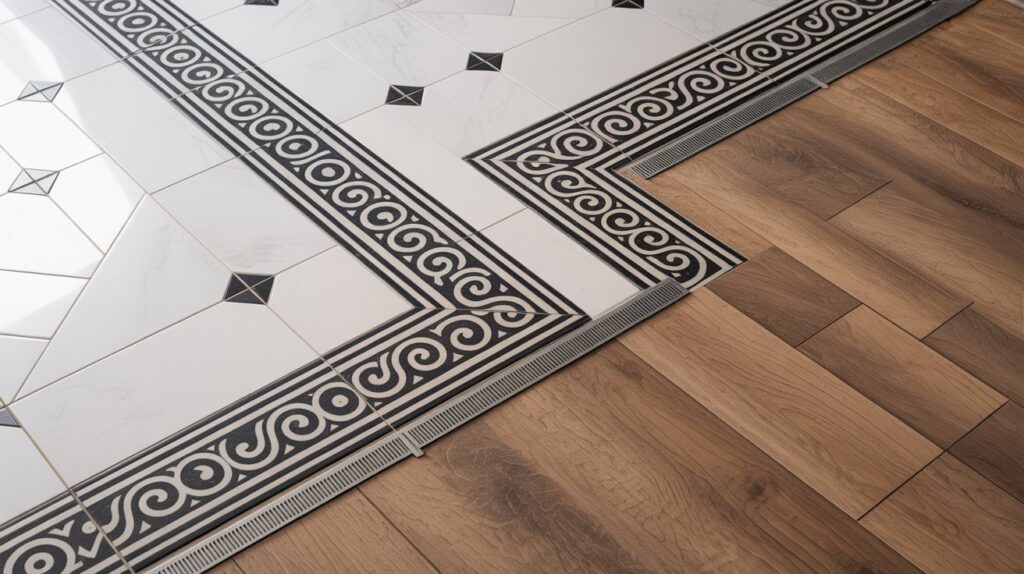I have been, or can be if you click on a link and make a purchase, compensated via a cash payment, gift, or something else of value for writing this post. As an Amazon Associate, I earn from qualifying purchases. Please read my full Affiliate Disclosure for more information.
Edge treatments shape mood, durability, and flow, so you set the room’s rhythm from floor to wall. Beveled, square, or micro-radius edges alter light, shadow, and perceived room height, guiding the eye and enhancing material character. They protect joints, resist moisture, and prevent chips where impact happens most. Properly matched to trim, cabinetry, and color, these details elevate cohesion and longevity. Want cohesiveness you can feel underfoot? There’s more you’ll want to explore beyond this.
Key Takeaways
- Edge treatments shape room rhythm, guiding eye movement from floor to walls for a cohesive look.
- Profiles like beveled or eased create light and shadow that add depth and character.
- Decorative borders introduce movement and visual interest without compromising seam integrity.
- Proper sealing and moisture-resistant edges protect joints, enhancing perceived quality and durability.
- Coordinated edge finishes with cabinetry and walls unify color, material character, and overall elegance.
Understanding Edge Treatments: What They Are and Why They Matter
Edge treatments are the subtle details that finish a floor’s look and function; they protect edges from chipping and moisture while guiding shifts to walls, stairs, or rugs. You’ll learn that edge treatments are deliberate choices, not afterthoughts, influencing both durability and flow. A decorative border adds character without compromising strip integrity, while edge sealing guards against spills and wear at junctions. Understanding these options helps you plan connectors, accommodate expansion, and maintain clean lines. Precision in selecting profiles, materials, and finishes ensures a cohesive, lasting appearance. When you choose wisely, your flooring reads as a unified, thoughtfully engineered surface.

Edge Styles and Their Visual Impact on Hardwood, Tile, and Luxury Vinyl
You’ll notice how each edge style alters the room’s rhythm, guiding the eye from floor to wall and shaping the perception of space. Edge profiles influence how hardwood, tile, and luxury vinyl read in light and shadow, from beveled to square, micro-radius to eased. You’ll see how decorative patterns emerge at junctures, creating subtle movement without overpowering the surface. Precision in edge choice supports color coordination, tying trim, grout, and core tones into a cohesive palette. The right edge style enhances seam continuity, improves perceived room height, and reinforces material character, delivering refined elegance with minimal distraction.
Durability, Maintenance, and Practical Considerations for Edge Finishes
While edge finishes can elevate a floor’s look, they also demand practical consideration: durability, maintenance, and everyday performance drive your long-term satisfaction. You’ll prioritize toughness against impact, moisture, and wear, choosing profiles that resist chipping and splitting. Maintenance becomes predictable: wipeable surfaces, compatible cleaners, and periodic resealing to preserve sheen and color. Consider color coordination and material compatibility to avoid mismatched tones or sluggish aging between trim and substrate. Realistic expectations matter: plan for expansion gaps, easy repairs, and compatibility with progressions. With thoughtful selection, edges stay elegant, functional, and consistent through daily use and seasonal changes.
How to Choose Edge Treatments to Match Design Goals and Lifestyle
Choosing edge treatments that align with your design goals and lifestyle starts with clarity about how you live and what you value. To select effectively, assess room function, traffic, and desired mood. Color coordination matters: match trim finishes to cabinetry, flooring, and wall hues for unity or deliberate contrast. Budget considerations shape material choices, edge profiles, and installation timing—prioritize durable options in high-traffic areas. Consider maintenance needs and future-proofing, opting for timeless profiles you won’t tire of. Finally, test samples in natural and artificial light to confirm perception, ensuring the finish elevates the space without overpowering it.
Installation Tips and Common Pitfalls for Seamless Edges
Even seemingly small mistakes can throw off the whole edge, so start with precise measurements and clean substrate. You’ll achieve seamless edges by preparing substrates, selecting proper materials, and following manufacturer guidelines. Prioritize color coordination to guarantee a cohesive look across transitions and trim; mismatched hues can read as DIY flaws. When installing, opt for the right tool selection—sharp blades, spacers, and edging tools—so cuts stay clean and accurate. Work slowly near corners and transitions, checking for gaps and lippage. Avoid shortcuts, maintain consistent adhesive amounts, and verify alignment before final set. With care, edges stay crisp and visually integrated.
Conclusion
You now know why edge treatments matter and how they shape texture, light, and flow in every room. From bold borders to subtle bevels, the right finish ties flooring to vision. Consider durability, maintenance, and your lifestyle as you match edge style to material. With a confident choice, you’ll elevate aesthetics without sacrificing practicality. When in doubt, aim for seamless progressions and timeless detail that won’t date your space. Your floor, perfectly framed, speaks volume.

Leave a Reply